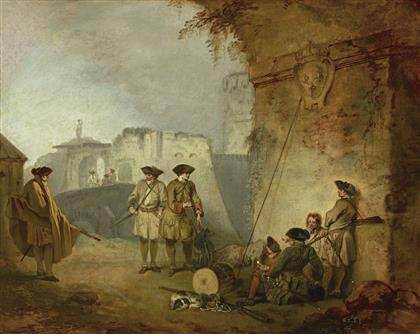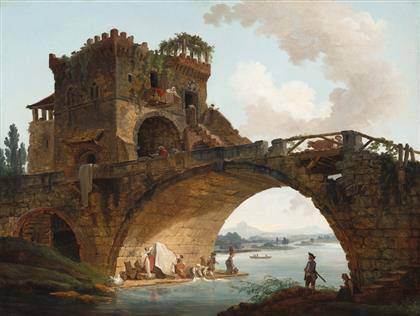
Jean-Antoine Watteau (1684–1721)
The Portal of Valenciennes
ca. 1710–11
oil on canvas
The Frick Collection; photo: Michael Bodycomb
‘Watteau’s Soldiers’ at the Frick Collection The Frick Collection presents ‘Watteau’s Soldiers: Scenes of Military Life in Eighteenth-Century France’, thefirst exhibition devoted to Watteau’s captivating and little-known military scenes. July 12 through October 2, 2016.]]>
Source: The Frick Collection
On display are four of Watteau’s seven surviving military paintings and twelve red chalk studies, several of which are directly related to the paintings on view. Also included are works by Watteau’s predecessors and followers. Together, they shed light on Watteau’sunusual working method, affording the opportunity to probe what made his vision so distinctive.
Most know Jean-Antoine Watteau as a painter of amorous aristocrats and melancholy actors, a dreamer of exquisite parklands and impossibly refined fêtes. Few artists would seem further removed from the misery of war. And yet, early in his short career, Watteau created a number of military scenes—about a dozen paintings and some thirty drawings. For the most part, they were executed during the War of the Spanish Succession (1701–14), which saw Louis XIV battle almost the whole of Europe in a bid to place his grandson, Philip, Duke of Anjou, on the Spanish throne. However, neither the turmoil of battle nor the suffering that ensued seems to have held much interest for Watteau. Instead, he focused on the prosaic aspects of military life—marches, halts, and encampments.
The resulting works show quiet moments between the fighting, outside the regimented discipline of drills and battle, when soldiers could rest and daydream, smoke pipes and play cards. Although these themes are indebted to seventeenth-century Dutch and Flemish genre scenes, Watteau’s drawings and paintings are set apart by their focus on the common soldier. More than his predecessors, Watteau offers an intimate vision of war, one in which the human element comes to the fore. His soldiers are endowed with an inner life, with subjectivity.
Related content
Jean-Antoine Watteau’s drawings go on view at the Royal Academy of Arts (exhibition, 2011)
Follow us on:


